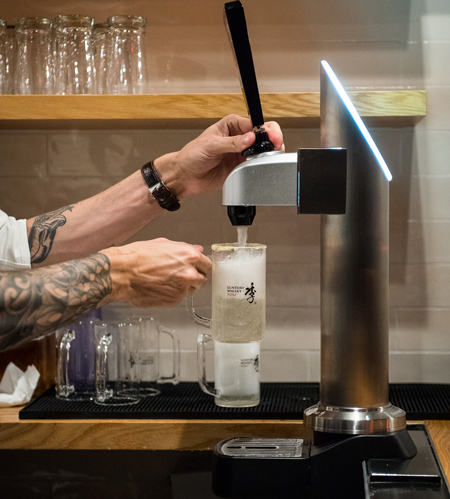1. Barrel-Aged Cocktails and Wine
Barrel-aged cocktails continue in popularity at bars looking to make things easier on their bartenders while offering guests a fun new option in drinks.
Not only does the aging of the cocktails in wine or bourbon barrels enhance the potency and flavor of the drinks, but it also helps preserve the alcohol as another way for bars and restaurants to pinch profits. This is particularly the case with wine bottles, which, once opened, will typically go bad the more staff open and close them. A growing number of operators now use tap systems to serve and preserve tequila, per Dave Kincheloe, president of National Restaurant Consultants, which has offices in Denver and Phoenix. Like wine, tequila can be sensitive to air exposure. Purchasing kegged wines and spirits also helps operators cut down on packaging, and therefore, waste.
 The Japanese whiskey highball is growing in popularity in the U.S. Photo of Suntory Whisky2. The Japanese Highball
The Japanese whiskey highball is growing in popularity in the U.S. Photo of Suntory Whisky2. The Japanese Highball
Served as a precise blend of whiskey and cold, sparkling water poured over a generous serving of ice, the highball has been a favorite of whisky drinkers in Japan since the 50s. That country was first introduced to the American spirit during WWII, according to Gardner Dunn, U.S. Brand Ambassador for Suntory Whisky. Today, Japanese consumers still favor their highballs, typically with yakitori (skewered, charcoal-grilled meats) at Izakayas (Japanese pubs) and other bar-friendly joints. Here in the U.S., the refreshing Japanese whiskey highball is gaining traction at ramen restaurants, sushi and Izakaya joints and trend-forward cocktail bars like Karasu and Kinfolk 94 in New York and Pacific Cocktail Haven in San Francisco. The drink, Gunn noted while guiding a tour of Chicago restaurants that serve highballs, seems to have caught on among younger bar-goers, happy hour patrons and brunchers looking for a lower alcohol beverage they can consume more readily during the day or over many hours at a stretch. In response, Suntory Whisky’s TOKI brand (Toki means “time” in Japanese) and its Jim Beam brand have partnered with manufacturers to develop their own highball draft machines in an attempt to recreate the precise Japanese method of gently stirring the ice to chill the whiskey 13 ½ times to the left and then adding soda water down the arm of a spoon so as not to burst the bubbles. These machines, which also double for use as a standalone soda water tap, deliver one part of very-chilled, whiskey or Japanese whisky with three parts chilled and highly carbonated soda water (five times the carbonation of regular soda water) directly into a glass containing the ice and an optional twist such as grapefruit, lemon, orange or even a splash of yuzu syrup. TOKI currently has 35 of these machines installed in 16 markets including Chicago, New York City, Los Angeles, San Francisco and Washington, D.C.
 The shared cocktail trend takes form as a watermelon punch drink at Punch Bowl Social. Photo Courtesy of Punch Bowl Social
The shared cocktail trend takes form as a watermelon punch drink at Punch Bowl Social. Photo Courtesy of Punch Bowl Social
3. Shared Cocktails and Punch Bowls
Just as shared plates do for food, shared cocktails make socializing over drinks more communal. Picture big fishbowls filled with creative cocktails and multiple straws meant for two, three or more people to sip at once. First made popular by rum-focused tiki bars like Blue Dragon in Boston and Three Dots and a Dash in Chicago, the trend continues to catch on at more traditional cocktail bars and restaurants. The Delta in Chicago, for example, serves three different vases (literally in floral-shaped, ornate glass vases) of creative cocktail mixtures with multicolored straws and garnished with nasturtiums and other edible flowers. The Mismatch and Flow combines vodka, allspice dram, seasonal fruit, honey, chamomile and ghost chile in a playful departure from fruity sangria. With plastic straws getting a bad rep these days, some bars have swapped out the less eco-friendly sippers with reusable metal, biodegradable plastic or thicker-quality paper straws. Along the lines of the shared cocktail craze, punches are having a moment as well. At Punch Bowl Social, with various locations around the country, big batches of boozy concoctions come served in fancy glass punch bowls, complete with ornate ladles and even small handled glasses with intricate etchings for an almost Southern-brunch-like feel.
4. Slushies
More bartenders these days continue to pull out their old blenders or buying new ones to whip up icy, boozy beverages on the fly. In addition, once reserved for perhaps more cheesy, tourist-driven posts, “slushie machines have come back in a big way,” bar consultant Peter Vestinos noted during FE&S’ Bar Design Webcast. Despite the added space requirements, bar operators often favor blended beverages because they combine less-costly ingredients with ice for a higher profit margin. Blenders can also be used to make crushed ice for refreshing cocktails as well.
 Etta in Chicago opted for rose-colored bar tools for an eye-catching statement.5. Rose All Day
Etta in Chicago opted for rose-colored bar tools for an eye-catching statement.5. Rose All Day
It seems the frose/rose trend that first hit the scene last year continues and in some markets has even had an impact on the color of barware and supplies. At the newly opened Etta in Chicago, bar manager Aaron Pollack sourced bright, rose-colored martini shakers, strainers, stirring sticks, jiggers and other tools. Adding to the theme, a wire basket holds limes and lemons for an eye-catching, statement look at the bar and to pair with the bright and breezy, Cali-esque space.
WANT MORE?
Read more about cocktail trends and bar design in FE&S’ Trends in Bar Equipment and Design story and in FE&S’ Bar Design Webcast with Peter Vestinos and Tobin Ellis, two veteran mixologists and bar consultants.




